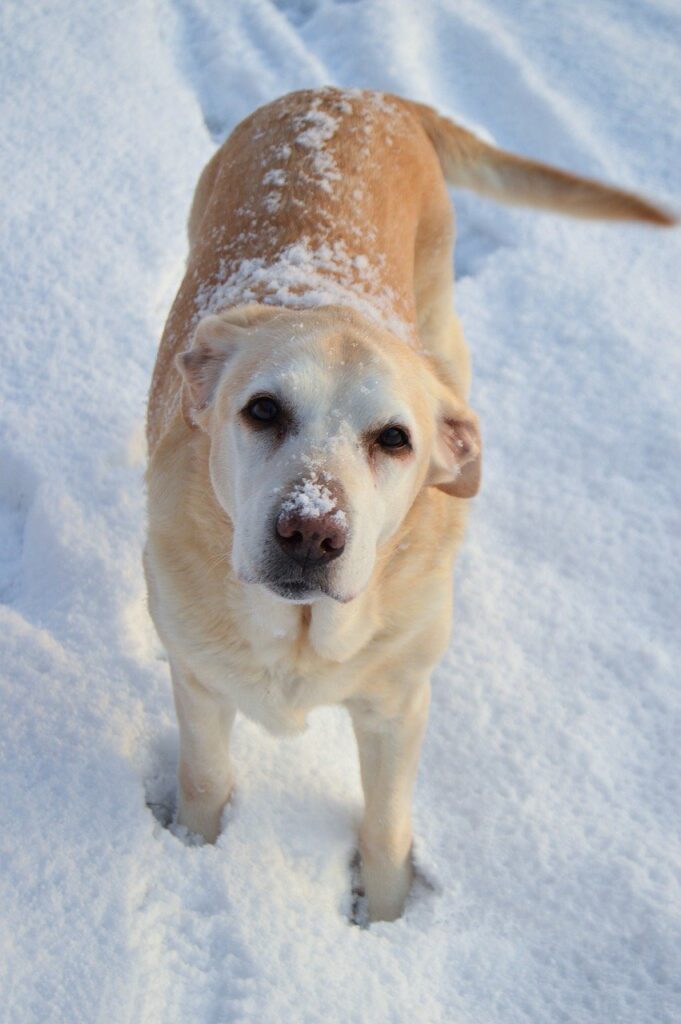Dogs all cope with cold weather differently.
Breed plays a part. So does age, size and weight. You will also have to factor in the climate you’re living in and what type of temperature your dog has been used to in the past.
We’re looking specifically at Labradors. They’re a popular family pet. We’ve met quite a few over the years and almost all of them have been spoiled rotten. They’ve enjoyed big warm beds, blankets and having the run of centrally heated homes. It’s easy to forget that these are hardy animals and that their ancestors were bred to survive the icy cold blasts of Newfoundland.
Labradors often enjoy the colder weather but low temperatures can be dangerous for any dog. So how cold is too cold for labs?
How Cold is too Cold for Labs?
Labradors have two coats. Most dog breeds only have one. This automatically gives your dog an advantage in colder weather. Double-coats help insulate both from cold air and cold water. Useful when Labradors are known for their love of swimming; it means they’ve developed a way of keeping warm even in very cold water. That doesn’t make them invincible to the cold nor should you assume that double-coat breeds are immune from the serious health conditions that can arise from over-exposure to low temperatures. There’s no hard-and-fast rule when it comes to what’s too cold for labs. It depends on several factors which means it’s often up to owners to use common sense and specific knowledge of their dog to decide when it’s too cold.
But 45-degree is a good place to start. This is the temperature where your dog may start feeling cold. Larger breeds or working dogs are often fine at this temperature but smaller ones won’t be. Anything under 20-degrees is considered too cold and your dog should not be outside in those temperatures. Don’t use these numbers as a baseline, however. Your lab may start getting cold at a warmer temperature.
Older dogs have a lower tolerance for the cold. Cold air makes it harder for them to regulate their body temperature. You may find they feel wintery weather more keenly than when they were younger.
Puppies are also more susceptible to cold weather so keep a close eye on them in lower temperatures. Puppies tend to bound through the snow but this should be limited. Jumping up and down in deep snow can impact their underdeveloped bones and joints.
Underweight dogs will feel cold weather more keenly.
One important metric to look out for is the wind chill factor. You should always pay attention to this as it can turn a low temperature into one that becomes more serious. Wind chill relates to the way temperature feels and how body heat is lost. The same temperature over two consecutive days may feel very different on a human or dog’s body when they’re a sharp wind accompanying it. This is an important thing to remember if your dog has been swimming in cold water.
Its not just the colder temperatures but what comes with it. Snow and sleet will mean the dog’s coat gets wet and a wet dog will be colder for longer.
Labradors are keen swimmers, and it’s good that they’re able to exercise their love of the water even in the winter but they can quickly start getting too cold if they’re not dried off or warmed up once out of the water. Often, there’s a big difference between being cold and dry and cold and wet. It’s often best to encourage swimming towards the end of a walk so that you can get your dog into a car or the warm soon afterwards.
Certain health conditions can also be exacerbated by the cold. Dogs with heart disease or diabetes should be particularly careful.
Always supervise your dog in the colder weather when they’re outside.
Outdoor or working dogs often fare better in the cold weather. Your indoor dog might not appreciate the sudden drop in temperature. Take your lead from the dog. If necessary, start trying to build up their tolerance for the cold gradually but otherwise just adapt to your dog’s temperament and experience.
Temperatures drop overnight so be aware if you’re camping with your dog.
Do Labradors need a coat in winter?
It depends on where you’re living and the temperatures your dog is exposed to. Coats aren’t often necessary somewhere like the UK, for example than in Canada. There are no hard-and-fast rules. Make a judgement based on your dog. If your dog is old or unwell, then a coat may be necessary so it may be wise to speak to a veterinarian. Some dogs lose fur through allergies and this may necessitate a jacket or coat. In places like Alaska or Canada, dogs that are likely to be standing around for a long period may benefit from some extra insulation. You may find some of the information on this forum useful.
How cold is too cold for labs to swim?
Labradors used to dive into the frigid Canadian waters to pull in the fishing nets; their ancestors could handle cold water but it’s worth being cautious. Again, all dogs are different. A lab’s undercoat will help keep them warm in the water but a dog mustn’t be left standing around when wet because their body temperature can drop quickly. Let them shake it off and run around afterwards. Some dogs won’t go into the water when it’s too cold so don’t push them if they’re not interested. Be careful when throwing balls and toys into the water as some retrievers will keep going back in until the game is finished and that can be dangerous.
It’s tough being a dog owner. There are so many differences between breeds and even the difference between individual dogs can make it hard to know what’s best to do.
Take into consideration a dog’s age, health and weight as well as its personality and previous history. Pay attention not only to the temperature when it drops but also to the wind chill factor and any precipitation. Keep cold water swims to the end of a walk and once they’ve stopped running around, get them somewhere warm to dry off. Labs are tough old dogs and with a little careful thought on the part of the owner, they’ll have a ball bouncing around even when it’s cold outside.


